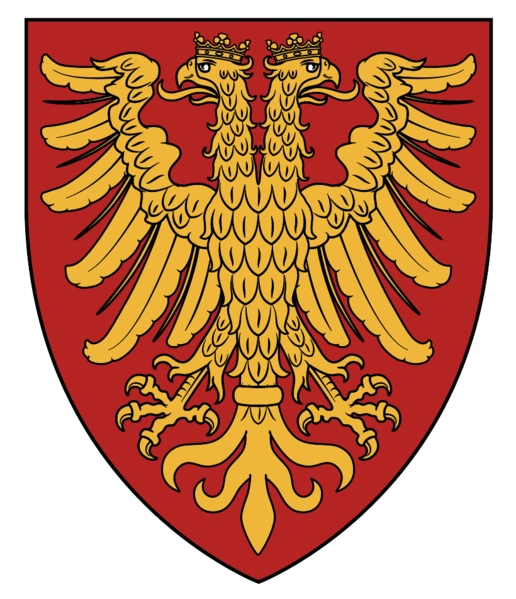Sometimes scattered pieces of historical information fit together to form a picture of the past which, whilst not definitive, appears plausible. Such is the case of Helena Notaras, the elder sister of Anna Notaras.
Loukas Notaras was among the wealthiest (if not the richest) man in mid-15th century Constantinople, holder of several important court functions, in 1441 he sailed with George Sphrantzes and the Despot of the Morea (the future emperor Constantine XI) to Mytilene on Lesbos where Constantine married the daughter of the Lord of Lesbos, Dorino Gattilusio. The Gattilusio family, originally from Genoa, had been lords of Lesbos and the Cyclades archipelago for a century and had followed a policy of prudent integration with both their Ottoman and Byzantine neighbours: Dorino's aunt, Irene, had married the Byzantine Empeor John VII Palaiologos.
It would appear that Notaras took the opportunity to link his own family to a royal occasion by arranging the wedding festivities to be a double union. As well as Caterina Gattilusio's marriage to Constantine, Dorino's nephew, (Giorgio Gattilusio) took the hand of the eldest daughter of Loukas Notaras in 1441. Helena.
This was a prudent choice. For whilst Dorino Gattilusio ruled Lesbos, his brother Palamedes was ruler of Ainos (modern day Enez), a small city on the Thracian peninsula and Giorgio was his father's heir. [It's a measure of the inter-related nature of medieval aristocracy that two of Giorgio's sisters married Campofregoso brothers, both of whom served as doge of Genoa in their time]. The Notaras were a merchant family, originally from Monemvasia with estates in the Morea, Kythera & strong links to Genoese merchant familes including the Gritti and Lomellini, so a marital link into the Genoese Gattilusio was likely as much about business as imperial prestige. Loukas Notaras's father Nicholas had obtained Genoese citizenship in the 1390s while negotiating grain contracts on behalf of the emperor John VII.
Both Helena & Constantine's marriages to the Gattilusio cousins were tragically short lived. A year after the wedding festivities, while travelling from the Morea, Constantine's ships ran into a Turkish pirate fleet and took shelter on Lemnos. There Caterina died of complications from a miscarriage. It was the second time Constantine had been widowed in this way. He never married again.
Helena's husband Giorgio also died young, in 1449. By then, Helena had born him at least two children. We don't know if Helena and the children remained living with Palamedes Gattilusio in Ainos at this time but it's clear Helena did not give up her interest in her husband's estate. The Gattilusi of Ainos paid a tribute to the Ottoman Sultans and Mehmed's army left the city unmolested on its march to Constantinople.
The Lord of Ainos was the first to pay respects to Mehmed as the new ruler of Constantinople and it seems that at this point Helena began to try and negotiate the ransom of her two sisters (her mother having died on the march to Adrianople). If she tried to also obtain her brother Jacob's freedom at this time it was impossible - since he had converted to Islam and joined the Sultan's palace school as a page.
The ransom negotations for Theodora and Maria Notaras were prolonged - it took almost two years to be completed - and complicated by a legal question which arose in Italy over what should happen to the vast Notaras family fortune which was frozen in the Bank of St George in Genoa. That issue was not fully resolved until 1459, but in the meantime the ransom of the girls was set at 700 ducats - by far the highest ransom rate of any recorded among abductees of the fall. This as much as anything shows the status of the Notaras family at this time as second in social rank only to the imperial family of the Palaiologoi.
Meanwhile in Ainos, two years after the fall, Palamedes Gattilusio himself died at the age of c.65 year old (perhaps at shock from the ransom his daughter-in-law was seeking to pay!). With Giorgio long since dead, the title of Lord of Ainos by rights should have passed to any son Helena had born. Instead, Giorgio's brother Dorino claimed the lordship. We might assume that one of Helena's children was indeed a boy, because in late 1455 she appealed to the sultan for him as suzerain of Ainos, to uphold her child's inheritance rights. An unnamed uncle was dispatched to petition the Ottoman court.
Dorino Gattilusio's brief rein over Ainos does not seem to have been a happy one. Turkish records indicate that Helena's was not the only complaint which had been raised against him and judges from local Turkish towns had also blackened his name. Whether it was in response to this or not, we know that a squadron of 10 ships under Yunus Pasha set out from Constantinople and bore down upon Ainos on 25th January 1456 [It's not clear if this is the same man as 'Yunus Bey' aka Thomas Katabolenos, Greek secretary to the Sultan who would be killed in the failed ambushing of Vlad Dracula in 1461].
Gates of Ainos
Dorino had the good fortune to be out when the long arm of Turkish justice came knocking that January. He was on Samothrace, another of the islands under Gattilusio control. The people of Ainos opened the gates to Yunus Pasha without contest and the town fell under Turkish control and remains so to this day. What happened to Dorino is a story for another day.
Governorship of the town was given to Demetrios Palaiologos in 1463 when the Morea was conquered but it appears to never have been handed over to Helena Notaras or her son. Instead Helena vanished from historical sight in 1456 until we see her mentioned in the last will and testimony of her younger sister Anna and even then it is a posthumous reference. By 1493 it appears that Helena had taken the monastic name of Euphrosyne and subsequently died but we have dates for neither. We also have no certainty over whether she joined Theodora and Anna in Italy or what happened to her children. One possibility is that in 1456 they joined their young uncle Jacob in the Ottoman palace school and grew up as Janissary as many of the children of fallen Constantinople did (the siege of Malta in 1480 was commanded by Mesih Pasha, a young scion of the imperial Palaiologoi who had been ten at the time of the fall).
Euphrosyne, Goddess of Joy and Mirth, was the name Helena chose to take in later life (although she probably had St Euphrosyne of Alexandria in mind)
The mystery of Helena's life between Girogio's death and her death as the nun 'Euphrosyne' will likely never be fully resolved. But following the strands along their lines of possible continuation are a good measure of how inter-connected the aristocratic families of Genoa, Serbia, Byzantium and even the Ottomans were at this time.




No comments:
Post a Comment
Note: only a member of this blog may post a comment.